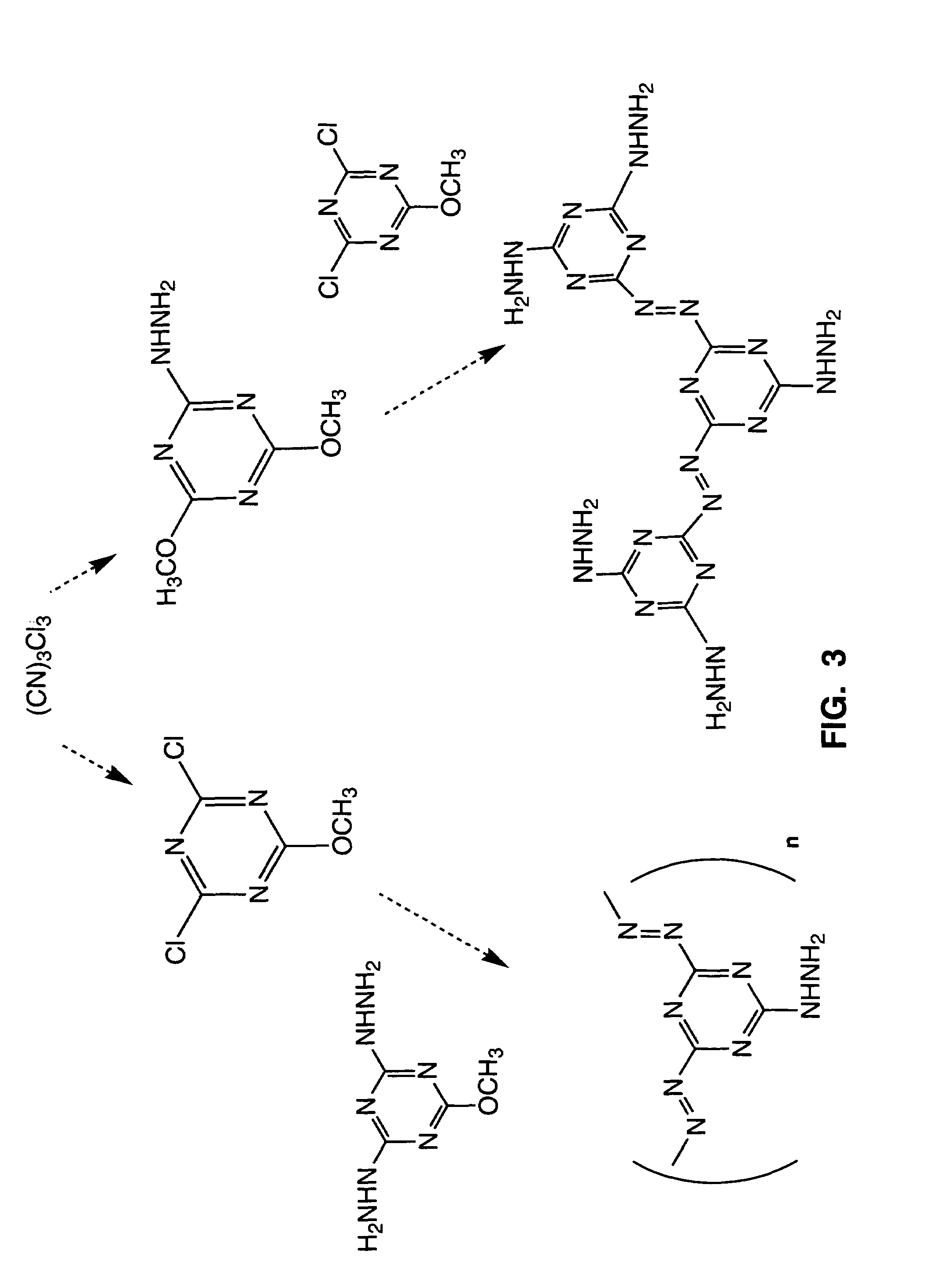High-energy 1,3,5-triazinyl diazenes, and process thereof
a technology of triazinyl diazene and high-energy, applied in the field of high-nitrogen energetic compounds, can solve the problems of rocket motor propellant formulation, motor failure, and decrease in stability and safety properties
- Summary
- Abstract
- Description
- Claims
- Application Information
AI Technical Summary
Problems solved by technology
Method used
Image
Examples
example 1a
Formation of N,N′-Bis-(4,6-dimethoxy-1,3,5-triazin-2-yl)-hydrazine
[0029]Hydrazine monohydrate (1.72 g, 34.4 mmol) was added slowly to a solution containing chloro-dimethoxy-triazine (12.1 g, 68.9 mmol.), K2CO3 (9.52 g, 68.9 mmol.), and 100 mL of isopropanol. After several hours at 50° C., the initially white, opaque mixture turned slightly pink. The mixture was stirred and heated overnight. A light-pink solid was isolated by filtration and a water wash. After oven drying, a white solid product was obtained (10.6 g, 99%): mp 222-4° C., 1H-NMR (d6-DMSO): 9.751 (N—H, 2H)3.855, 3.764 (—OCH3, 12H), (CDCl3): 7.45 (N—H, 2H) 3.95, 3.91 (—OCH3, 12H), 13C-NMR (d6-DMSO): 172.2, 171.7 (—C-OMe) 169.5 (C—NHNH), 54.4, 54.2 (—OCH3). (see P. Loew and C. D. Weis, J. Heterocyclic Chem., 1976, 13, 829).
example 1b
Preparation of N,N′-Bis-(4,6-dichloro-[1,3,5]triazin-2-yl)-hydrazine
[0030]Note: Contact of the hydrazine reagent with metal prior to its addition to the reaction solution can cause unwanted oligomerization reactions. A suspension of cyanuric chloride (18.4 g, 100 mmol) in THF (100 ml) was cooled to −15° C. A solution of hydrazine monohydrate (7.51 g, 150 mmol) in water (10.0 mL) was added dropwise to the stirred cyanuric chloride suspension over 5 min, and the reaction mixture was then stirred at 0° C. for 30 min.
[0031]Cold water (4° C., 100 mL) was added to the reaction mixture, and after the oil was allowed to separate (ca. 5 min), the aqueous layer was decanted. After two more aqueous washings and decantations with cold water, warm water was added (40° C., 100 mL) and the reaction mixture was allowed to sit for 5 min. The remaining yellow solid was vacuum filtered using a Whatman #1 filter, and then washed with water (RT, 4×25 mL) and CHCl3 (2×25 mL). The yellow powder was dissol...
examples 1a and 1b
Example 1c
Prep. of N,N′-Bis-(4,6-dimethoxy-[1,3,5]triazin-2-yl)-hydrazine (1a)
[0033]To 0.5 g (1.5 mmol) of 1b in 1.2 ml of methanol was added 1.2 ml of a 5.4M methanol solution of sodium methoxide (7.0 mmol). A yellow suspension formed, and was stirred at room temperature for about 48 hours. The suspension was then concentrated by rotary evaporation to obtain a solid. Evaporation of an acetone extract of this material gave the product 1a, which was identical to the product produced in the chlorodimethoxytriazine reaction with hydrazine in Method A.
PUM
| Property | Measurement | Unit |
|---|---|---|
| chemical structure | aaaaa | aaaaa |
| stability | aaaaa | aaaaa |
| pressure | aaaaa | aaaaa |
Abstract
Description
Claims
Application Information
 Login to View More
Login to View More - R&D
- Intellectual Property
- Life Sciences
- Materials
- Tech Scout
- Unparalleled Data Quality
- Higher Quality Content
- 60% Fewer Hallucinations
Browse by: Latest US Patents, China's latest patents, Technical Efficacy Thesaurus, Application Domain, Technology Topic, Popular Technical Reports.
© 2025 PatSnap. All rights reserved.Legal|Privacy policy|Modern Slavery Act Transparency Statement|Sitemap|About US| Contact US: help@patsnap.com



